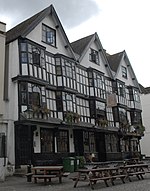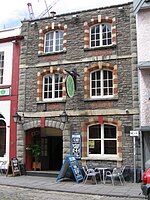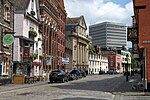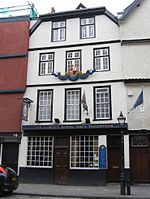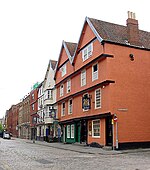7 and 8 King Street, Bristol
1665 establishments in EnglandBristol building and structure stubsGrade II* listed buildings in BristolHouses completed in 1665Houses in Bristol ... and 2 more
Timber framed buildings in EnglandUse British English from February 2023

7 and 8 King Street are a pair of historic houses situated on King Street in Bristol, England. They date from 1665. During restoration in 1976 it was found that recycled ships timbers had been used for much of the oak studding and bracing in the buildings, and barrel staves had been used as laths. The oriel window of number 7 is an original feature, whilst the windows of number 8 were replaced during the eighteenth century.7 and 8 King Street have been designated by English Heritage as a grade II* listed building.
Excerpt from the Wikipedia article 7 and 8 King Street, Bristol (License: CC BY-SA 3.0, Authors, Images).7 and 8 King Street, Bristol
King Street, Bristol City Centre
Geographical coordinates (GPS) Address External links Nearby Places Show on map
Geographical coordinates (GPS)
| Latitude | Longitude |
|---|---|
| N 51.4518 ° | E -2.5937 ° |
Address
Abbeywood Tots
King Street 7;8
BS1 4EQ Bristol, City Centre
England, United Kingdom
Open on Google Maps


